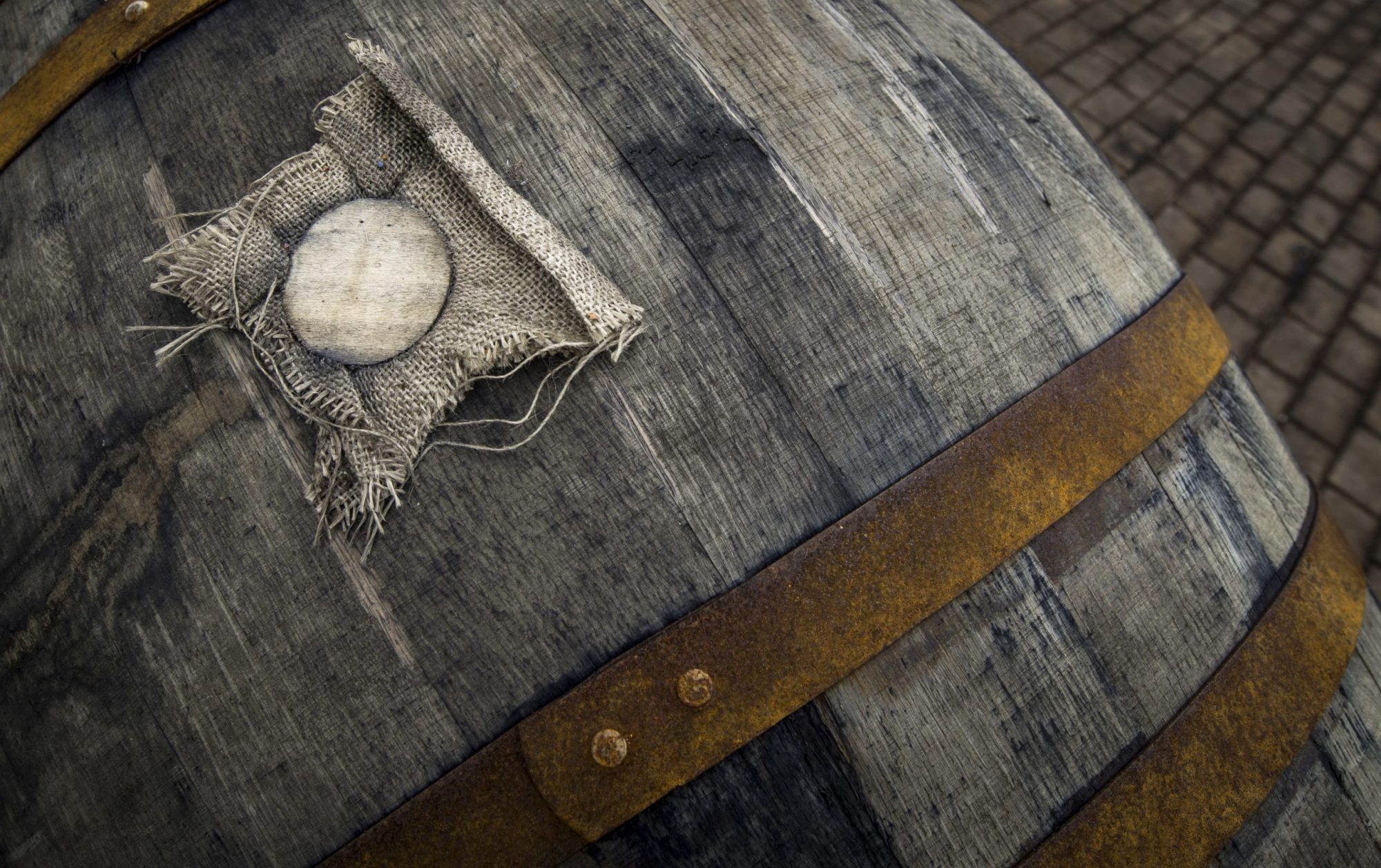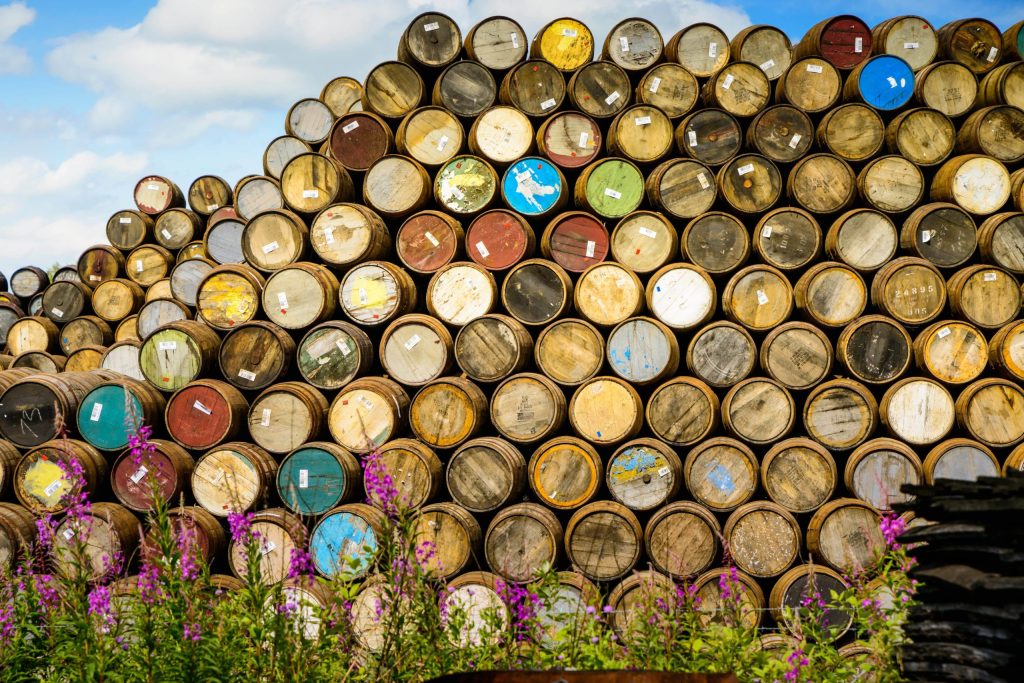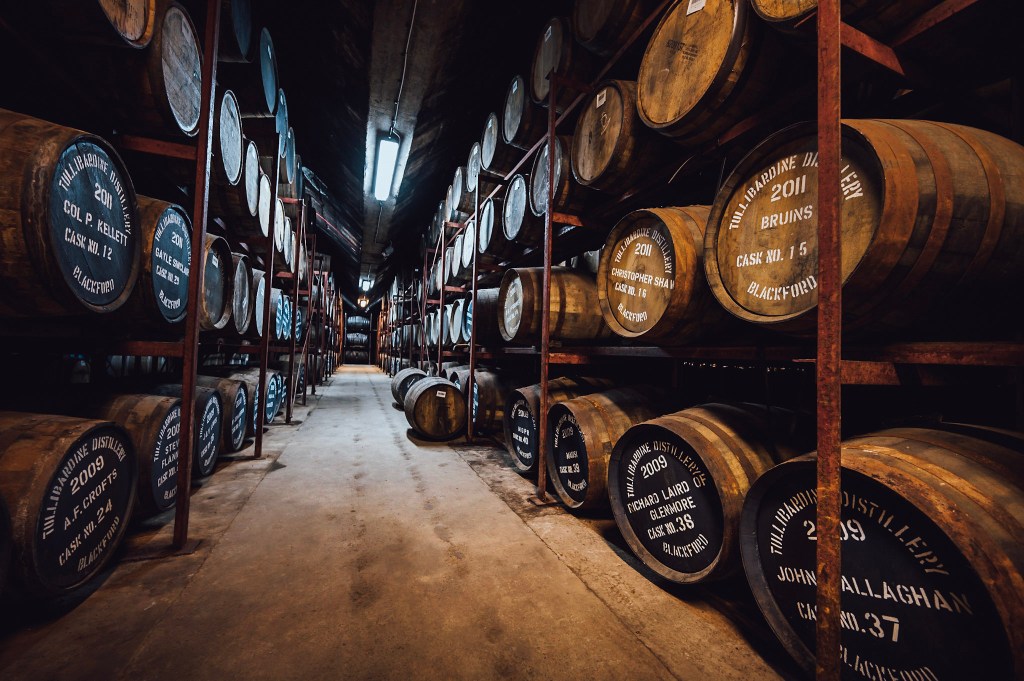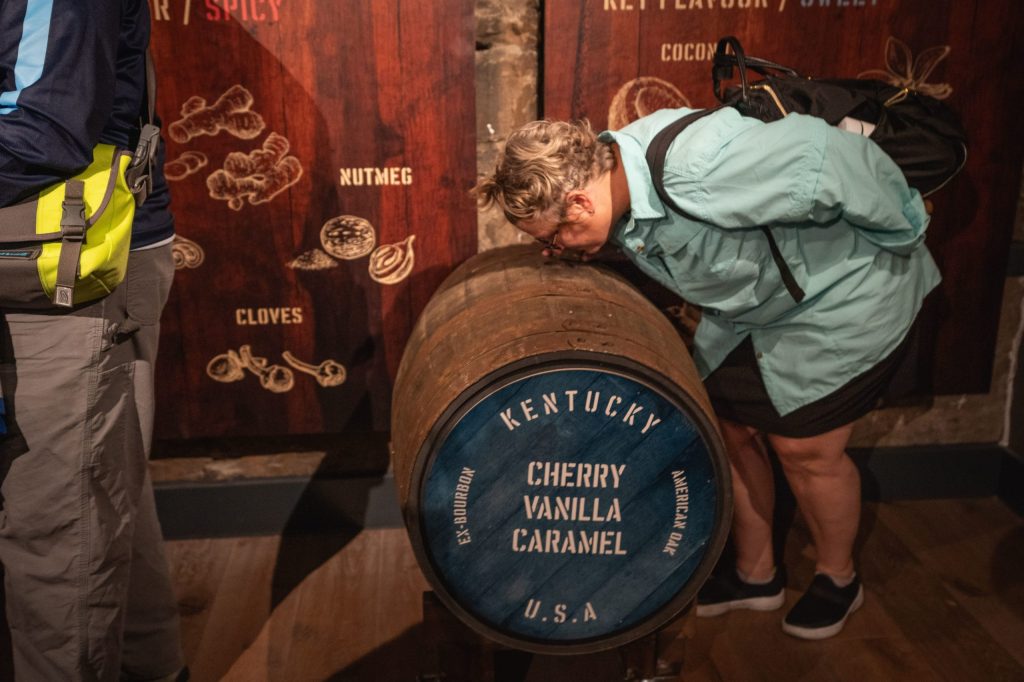How does maturation impact whisky flavour?

“The older, the better” – How often have we come across this belief when talking about whisky in a shop, at a tasting or at home?
In maturation, which is the process of leaving a spirit in a cask for a certain period (minimum three years for Scotch whisky) to extract flavour and colour, age is undoubtedly relevant and often, as the proverb goes, good things come to those who wait.
However, time is not everything, as many other factors come into play in this process, which can turn a relatively young whisky into a very flavourful dram that can surpass some older expressions.
Let’s take a closer look at how the cask influences whisky.
Wood and Cooperage

Speyside Cooperage – Photo: Visit Scotland
One of the first elements that come into play is the type of wood used to make the cask. For the Scotch whisky industry, it has to be oak wood, which is exceptionally malleable and lends itself to making suitable leakproof containers. Different species of oak are growing worldwide: American Oak and European oak (generally Spanish and French) are the most widely used by Scotch whisky producers. The latter is more porous than its American cousin and contains more tannins, imparting more woody and spicy notes.
Another essential element is the treatment used on the cask by the coopers (cask-makers): every barrel must be toasted before being filled for the first time. This process alters the chemical elements in the wood. It makes it possible for the spirit to absorb all the flavour compounds given by the wood, ranging from nutty, caramel, spicy, and vanilla notes to oaky and sometimes buttery ones, leaving just a darkened, black layer on the surface. This also reduces the level of tannins in the wood.
Casks such as the ones used for Bourbon are eventually charred: this process, mostly done on direct flame, burns the wood and leaves an uneven, cracked surface which may resemble an alligator’s skin. It creates a layer of charcoal, which will filter unwanted compounds such as sulphurs. At the same time, it will allow for an easier and deeper penetration by the spirit, making it easier for the flavours to be absorbed.
Each time the cask is filled with a spirit and throughout the ageing process, the content will take in the flavours and properties from the wood, which will absorb some of the liquid in return. This means that, after each use, the cask loses out on flavouring and colouring intensity until it becomes exhausted. This is why a first-fill cask will give more flavour and colour to the whisky than second or third-fill ones. After three uses, the barrels are generally brought to the coopers to be rejuvenated and re-charred, giving them a second life.
The quality of the cask is also essential to the quality of the whisky: especially for older whiskies, a barrel which endures the test of time is crucial for the final result.
Finally, we have to take into account where the casks are stored. The type of warehouse will impact the speed and quality of whisky maturation. There are mainly three types of warehouses in Scotland: the traditional dunnage warehouses, which are low and allow a more even temperature, and the more efficient racked and palletised ones, which, however, experience greater variety in temperatures, with higher rates of evaporation on the top layers. Studies have shown that this can impact the flavours of the whisky, with more fruity and woody notes highlighted in the top layers and more grassy and cereal notes on the lower ones.
The surrounding environment can also influence the whisky, as the porous staves “breathe” and allow, to some extent, the spirit to interact with the atmosphere (especially noticeable for whiskies matured in coastal regions).
Size

Speyside Cooperage – Photo: Visit Scotland
Casks used in the Scotch whisky industry come in different shapes and dimensions, and this will play an essential role in maturation, mainly due to the direct contact of the liquid with the wood. Smaller casks will allow the spirit to interact with the surface of the wood, producing a faster maturation. In contrast, increased capacities will mean reducing this contact and, therefore, diminishing the impact of the cask on the whisky. However, a faster maturation implies that a higher percentage of the spirit is lost over the years to evaporation.
The most widely used sizes of casks are:
Barrel (around 200 litres) is mainly used for Bourbon and is generally made with American Oak.
Hogshead (around 250 litres) is an enlarged ex-bourbon barrel to which staves have been added to increase capacity. A slightly larger cask means more whisky can be stored in one warehouse.
Wine Barrique (about 300 litres) is usually made of French oak and used to store wine or cognac.
Sherry Butt (about 500 litres) can be made out of European or American oak and is generally used to age sherry.
Port Pipe (about 600 litres) is made of European or American oak and is used to store Port. Generally, it has a more elongated shape.
Previous Liquids

Photo: Tullibardine Distillery
Nonetheless, the aspect which has the most significant impact on flavour is the previous content of the cask. Different products used in the cask’s previous life will impart different flavours to the whisky, and whisky makers can play with them to create an extremely variegated flavour palette.
Those most in use are:
Bourbon
The quintessential American drink, Bourbon, can be matured by law only in new, virgin casks, which have not been filled with other liquids before.
This turned out to be an excellent deal for Scotch whisky makers, which can buy ex-bourbon casks at a relatively low price, and this is one of the main reasons why this type of barrel is the most popular in the industry.
Flavours may vary according to the type of Bourbon used, but this type of cask gives out vanilla and coconut notes, sometimes with a creamy, buttery texture. The colour tends to be lighter, from hay to golden.
Recommendations: Clydeside Inaugural Release, Arran 10yo, Tullibardine Sovereign
Sherry
A fortified wine produced in Spain, near the town of Jerez, in Andalusia, sherry is the industry’s second most used type of cask. Unlike Bourbon, the industry favours older barrels, which are first seasoned with wine and can be reused multiple times. They tend to be quite expensive to purchase. Therefore, whisky distilleries often pay for the casks to be assembled in Jerez and seasoned with sherry just long enough for it to have the right influence for whisky maturation and have them sent to Scotland when ready.
Different types of sherry will give out different flavours: a Pedro Ximenez cask will give very intensely sweet, syrupy and juicy notes, whereas Oloroso sherry tends to be nuttier, with Amontillado or Fino giving out a sweet but drier character.
Sherry casks impart a deep sweetness, with notes of dried fruits like dates, Christmas cake, cinnamon, cloves, plentiful tannins, and oakiness, as well as rich amber or red colour.
Recommendations: Glendronach 12 or 15, Aberlour A’bunadh, Kilchoman Sanaig
Port
Another fortified wine, this time from Portugal, is mainly used to finish the whisky maturation as it can impart very rich flavours to the whisky and has been growing in popularity in recent years.
The various styles of Port can differ quite significantly in sweetness and dryness, resulting in different effects on the whisky matured in such casks.
Port-finished bottlings are mostly jammy and juicy, with notes of berries, blackcurrants, raisins, a warming spiciness and hints of dark chocolate. The colour is usually a rich red (mainly when a ruby port is used).
Recommendations: Tomatin 14 Port Wood Finish, Dalmore Port Wood, Talisker Port Ruighe
Rum
Relatively rare compared to whisky-matured Bourbon, sherry or Port, rum casks are growing in popularity in Scotch whisky production, with some excellent results. This spirit made out of sugarcane and in white (non-aged) and dark (cask-aged) styles, is usually used as a finish to Scotch, but there have been delicious expressions of rum full maturation.
This interaction gives some lovely tropical fruit notes to the whisky with a gentle sweetness—hints of vanilla, banana, apricot, syrup and almond nuttiness. Whether the rum is white or dark, the colour can range from bright tones to light amber.
Recommendations: Balvenie 14 YO Caribbean Cask, Glenfiddich 21 YO Reserva Rum Cask Finish, The Glenlivet Caribbean Reserve
Wine
The wine industry is another one which, in recent years, has found a natural partnership with Scotch whisky, with more and more distillers using wine barriques (mostly made using French oak) to add some refined tasting notes to their bottlings.
As the range of wine types and styles available is extensive, there are a lot of different variables in the flavours that they impart on whisky. However, we can broadly differentiate between red wines like Barolo or Bordeaux, which give out bolder flavours like red fruits, berries, plums and tannins. In contrast, white wines like Sauternes or Chardonnay typically bring in a light, zesty sweetness and tropical fruits with grassy hints and brighter colours.
Sweet wines like Muscat can instead bring more syrupy and spicier notes.
Recommendations: Glenmorangie Nectar d’Or, Nc’nean Organic Single Malt, Glen Moray 10yo Chardonnay Cask, Tullibardine 228 Burgundy Cask Finish.
Virgin Oak
The wood of a cask is “virgin” when it has not been previously filled with other spirits or liquids. Therefore, it will retain a high concentration of flavours that come from fresh wood and that have not been “absorbed” by a former inhabitant.
Therefore, Virgin oak casks tend to give a vibrant flavour to the spirit and can develop a strong taste in a short time, which is why it is not generally used on its own but is often added to ex-bourbon expressions.
You can expect robust woody notes and vanilla mixed with a warming spiciness and pepperiness from a virgin oak-matured whisky.
Recommendations: Deanston Virgin Oak, Glen Garioch Virgin Oak, Auchentoshan Virgin Oak.
Others
Whisky maturation is probably the side of production that has more extensively experimented with cask variations, and the number of other products that use this type of container has undoubtedly given the distiller’s imagination a good playfield.
Other examples are Madeira, Marsala and Brandy. Recently, regulators have opened up to the use of Mezcal and Tequila casks. Some distillers (although not in Scotland) have even used tea casks to mature their whisky!
It is important to note that Scotch whisky bottlings are often made from a mix of these casks. Except for Bourbon, most other liquors can have a powerful impact on the flavour of whisky and are generally used for finishing, meaning that the whisky will be moved to another cask to end its maturation process.
One should look for single cask bottlings, generally sold at cask strength (not diluted with water before bottling), to get the full flavour of one particular cask type.
However, most of the whisky produced, single malt or blend, will result from blending separate casks, which the master blenders will balance to obtain a particular flavour profile.
Conclusion

All these factors make every cask unique and mean that even a relatively young whisky can come packed with delicious flavours.
However, one cannot stress enough how the most essential factor in finding a good whisky is… your taste. You may enjoy very oaky and complex notes or find more pleasure in a neater, fruity and fresh dram.
How you taste and enjoy your whisky is entirely up to you, and you can level up your game with a few tips on how to taste your whisky at home.
A great exercise is tasting drams from different casks to see if you can detect the differences and find some of the flavours mentioned above.
Slàinte Mhath!
